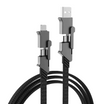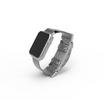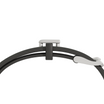The Science Behind Pavlok
Pavlok uses electrical stimulation to change smokers' behavior by delivering a mild shock when they reach for a cigarette, gradually reducing their urge to smoke over time.

Aversion Therapy
Pavlok is built on the groundwork of 80+ years of scientific evidence. We are in the process to file for FDA-clearance and run clinical tests, but these have not been completed and we are not a medical device.
To break bad habits, Pavlok uses the science of Aversion Therapy — the most effective treatment for breaking bad habits ever utilized.
Aversion therapy is Pavlovian Conditioning — associate the habit you want to stop, with a negative stimulus (like Pavlok’s zap) for a period of time, for a few days in a row. Rapidly, the brain learns to associate the two stimuli together, and stops *liking* the habit.
If you or a friend experienced excessive alcohol intake or food-related sickness, you likely understand this. When you get that sick, your reptile brain can instantly create a connection, causing you to stop liking that type of alcohol or food.

Studies
Pavlok is in the process of developing and conducting new studies for a variety of habits. We have begun in one project conducted in collaboration with University of Massachusetts at Boston, Pavlok was tested on a group of 8 people as a smoking cessation aid.

Smoking Cessation with Pavlok
A research project, conducted at University of Massachusetts, Boston.
Cigarettes and second-hand smoke are common causes of a multitude of medical problems and smoking is a notoriously difficult habit to break. This report is designed to increase awareness of smoking cessation options and improve effectiveness of cessation techniques. A complete literature review of smoking cessation options was conducted. Aversive conditioning — pairing an undesired action with a slight electrical shock — was identified as a successful smoking treatment in several studies from the past.
In this report, smokers used Pavlok, a product that allows the user to self-administer a slight electric shock. The subjects averaged 10-20 cigarettes per day previously, and were asked to self-administer a shock at every puff of a cigarette for a period of two weeks. Subjects also were offered social support throughout the testing period.
At experiment end, 75% of subjects had become completely smoke-free for at least a week, and 25% had cut down their cigarette intake by at least half. Data obtained from this test group indicates aversive conditioning is an effective method of smoking cessation and is extremely effective when paired with individualized social support.
Download the full paper21 Studies on Aversion
For over 80 years, doctors and scientists have dedicated their efforts to studying the efficacy of electric shock in behavior modification. Through rigorous testing, these researchers present their findings in peer-reviewed journals, which serve as valuable references for subsequent studies. This post comprises a compilation of scientific reports from renowned academic and medical institutions worldwide. Within, you'll find 21 article summaries that offer a glimpse into the robust body of research underpinning the development of Pavlok.
01
Up to 61.4% of subjects quit smoking within 5 days
A comprehensive follow-up study was conducted on 832 clients who underwent a commercial stop smoking program, approximately one year after treatment. The program utilized five days of aversive conditioning for various smoking behaviors, alongside educational counseling and a six-week support phase with weekly support groups and one conditioning reinforcement treatment in the second week. The clients were contacted around 13.7 months after completing the treatment, and 52% of them had achieved total abstinence from cigarettes since their program "graduation."
The study revealed that the most significant predictor of success or failure was whether the client returned to a home with a smoker. Among those returning to a nonsmoking home, 61.4% of men and 60.2% of women were successful in staying smoke-free.
In contrast, 70.2% of those who returned to a smoking household resumed smoking.
Overall, the treatment process appeared to be complication-free and yielded successful outcomes for the majority of clients. To potentially enhance the results further, simultaneous treatment of all household smokers could be considered.
Reference: Journal of Substance Abuse Treatment, Long Term Outcome of Clients Treated in a Commercial Stop Smoking Program, Vol. 5. pp. 33-36, 1988
02
81.8% of nail biters have significant nail growth with electric shock therapy
In this study, 61 subjects (31 males and 30 females) with an average age of 19.75 years and a history of nail-biting for about 12 years were randomly assigned to one of four groups:
- Shock
- Negative Practice
- Bitter substance
- Attention-placebo control.
The shock group received faradic shock using a generator capable of delivering 200 V at 10 mA. Half of the subjects in each group were asked to self-monitor their nail-biting during treatment.
All groups experienced increased nail growth, with no significant difference among them. However, subjects who self-monitored their nail-biting showed significantly greater nail growth (p<.05) compared to those who didn't self-monitor. Three months later, a significantly higher proportion of subjects in the three aversion treatment conditions had either stopped biting their nails or reduced the frequency (p<.05) compared to the control condition.
Furthermore, there was a noteworthy increase in awareness of nail-biting among individuals who still engaged in the habit (p<.01), with self-monitoring subjects experiencing this increased awareness primarily. These findings suggest that awareness plays a crucial role in reducing nail-biting behavior.
Reference: Vargas, John M., and Vincent J. Adesso. ‘A Comparison Of Aversion Therapies For Nailbiting Behavior’. Behavior Therapy 7.3 (1976): 322-329. Web.
03
Aversion Study Results In Sustained Weight Loss of 9.17 lbs
Favorite foods (CS) were paired with noxious odors (UCS) to help overweight subjects achieve and maintain weight loss.
The average age of subjects was 39.56 years with a range of 18-60 years and the average weight was 181.67 lbs with a range of 152-237 lbs.
All subjects had been defined as “overweight” according to the New Weight Standards (Statistical Bulletin, November, 1959) and also by their physicians. After the 9-week conditioning period, a significant (obtained p = 0.002, significant at p<0.05) average weight loss for the six experimental subjects of 13.33 lbs compared with an average weight loss of 1.00 lb for the six control subjects was reported.
After 48 weeks, the experimental subjects had an average weight loss of 9.17 lbs, while the control group had a weight gain of 1.33 lbs.
Reference: Foreyt, John Paul, and Wallace A. Kennedy. ‘Treatment Of Overweight By Aversion Therapy’. Behaviour Research and Therapy 9.1 (1971): 29-34. Web.
04
Skin scratching and hair picking disappear completely with 20 minute sessions
Behaviour therapy provides important psychotherapeutic possibilities for the treatment of dermatological disorders. Compulsive scratching and trichotillomania can be treated by aversive conditioning.
In documented case a man aged 33 suffered from severe lichen simplex on the scrotum, thighs and ankles, which had been present for 4 years and for which he had been admitted to the clinic three times, without any lasting result.
The patient was seen once a day for a 20 minute session. He was instructed to bring his hand to scratch at a sign from the therapist. At the moment his hand reached site he received an unpleasant, though not painful, electric shock via electrodes on the moving hand. He then had to draw back his hand and say aloud, ‘don’t scratch’. After 19 days of treatment the scratching disappeared completely.
Reference: BAR, LOUIS H. J., and BEN R. M. KUYPERS. ‘Behaviour Therapy In Dermatological Practice’. Br J Dermatol 88.6 (1973): 591-598. Web.
05
12 hours of treatment can extinguish a 12 yr habit
When contrasted with other psychiatric treatments the duration of aversion therapy necessary to break a chronic habit such as compulsive gambling is extremely short.
Case 1 required only 12 hours treatment to extinguish a behaviour pattern which had persisted for 12 years.He showed no tendency to resume gambling for 18 months. He relapsed once after a domestic upheaval and after losing his job. He was readministered for four “booster” treatments, during which he showed marked reluctance to gamble.
Apart from this single relapse he has not returned to gambling for more than two years. Mainly because of its convenience and practicability, electrical aver- sion therapy is now tending to replace all other aversion techniques (1, 38.)
Reference: Barker, J.C., and Mabel Miller. ‘AVERSION THERAPY FOR COMPULSIVE GAMBLING’. The Lancet 287.7435 (1966): 491-492. Web.
06
The Elimination of Chronic Cough by Electric Shock
The study presents a case in which aversion therapy was successfully used to eliminate a chronic cough in a 15 yr old boy. Treatment included electric shock aversion therapy employing a response suppression shaping paradigm to remove the cough, and ancillary family treatment to alter the reinforcement pattern which maintained the inappropriate behavior.
The subject has been free of cough for 1 1/2 yr since treatment. Significant aspects of the case relating to the use of aversion techniques are discussed. This paper is based in part on a presentation given at the Fifth Annual Meeting of the Association for the Advancement of Behavior Therapy, Washington, D.C., September, 1971.
Reference: Barney Alexander, A. et al. ‘The Elimination Of Chronic Cough By Response Suppression Shaping’. Journal of Behavior Therapy and Experimental Psychiatry 4.1 (1973): 75-80. Web.
07
1 Year Follow Up: 66.7% of Smokers Who Complete 5 Shock Sessions Still Not Smoking
Electric aversion was administered to 14 cigarette smokers. Six of the nine subjects who completed the treatment were still abstinent at one-year follow-up.
The overall average of 21.5 cigarettes on the day before treatment dropped to an average of 1.4 cigarettes per day after the third aversion session and most patients stopped smoking within five sessions. It is concluded that electric aversion is a powerful suppressor of cigarette smoking.
Reference: Russell, M. A. H. ‘Effect Of Electric Aversion On Cigarette Smoking’. BMJ 1.5688 (1970): 82-86. Web.
08
In 3 Sessions Electric Shock Creates Inhibition of Craving For Prescription Drugs
It seems likely that an important reason for the limited success of aversion treatment of drug addiction has been that the aversion is applied only to extrinsic stimuli associated with the drug. No attempt is ordinarily made to combat the endogenous habit. In the present experiment a subject with a Demerol (Pethidine) addiction of 3 years standing was instructed to give him- self a severe shock from a portable apparatus whenever he felt a desire for the drug arise endogenously. On three occasions he gave himself 4, 3 and 2 shocks respectively, dispelling the craving. For a period of 12 weeks the patient remained free from any but minor cravings that he could easily control.
Reference: Wolpe, Joseph. ‘Conditioned Inhibition Of Craving In Drug Addiction: A Pilot Experiment’. Behaviour Research and Therapy 2.2-4 (1964): 285-288. Web.
09
Aversion Therapy and Sensory Modalities: Clinical Impressions
Clinical findings suggest that the results of aversion therapy may be enhanced by choosing aversive stimuli which match the specific modalities under treatment. “White noise” was most effective in reducing auditory hallucinations; tactile stimuli (electric shocks) were most effective with motor compulsions; and an unpleasant olfactory-gustatory stimulus (an especially foul mixture of smelling salts) worked best with compulsive eaters. (PsycINFO Database Record (c) 2012 APA, all rights reserved)
Reference: Lazarus, Arnold A. ‘AVERSION THERAPY AND SENSORY MODALITIES-CLINICAL IMPRESSIONS’. Perceptual and Motor Skills 27.1 (1968): 178-178. Web.
You still don’t have yours ?
Embark on Your Journey to Better Habits Today with Pavlok.













![TRIPLE TIP CHARGING CABLE (USB-A to [Micro USB-B / Lightning / USB-C])](http://buy.pavlok.com/cdn/shop/files/Hydra_db2067bf-53f7-45e7-b9b9-d7947e4d472f.png?v=1706270717&width=104)
